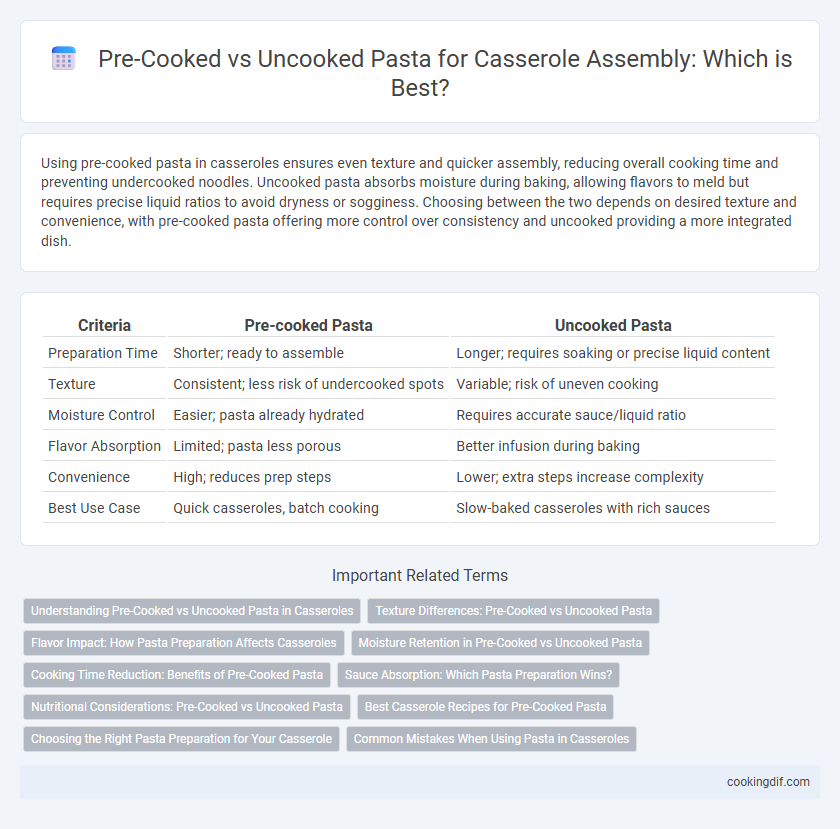Using pre-cooked pasta in casseroles ensures even texture and quicker assembly, reducing overall cooking time and preventing undercooked noodles. Uncooked pasta absorbs moisture during baking, allowing flavors to meld but requires precise liquid ratios to avoid dryness or sogginess. Choosing between the two depends on desired texture and convenience, with pre-cooked pasta offering more control over consistency and uncooked providing a more integrated dish.
Table of Comparison
| Criteria | Pre-cooked Pasta | Uncooked Pasta |
|---|---|---|
| Preparation Time | Shorter; ready to assemble | Longer; requires soaking or precise liquid content |
| Texture | Consistent; less risk of undercooked spots | Variable; risk of uneven cooking |
| Moisture Control | Easier; pasta already hydrated | Requires accurate sauce/liquid ratio |
| Flavor Absorption | Limited; pasta less porous | Better infusion during baking |
| Convenience | High; reduces prep steps | Lower; extra steps increase complexity |
| Best Use Case | Quick casseroles, batch cooking | Slow-baked casseroles with rich sauces |
Understanding Pre-Cooked vs Uncooked Pasta in Casseroles
Pre-cooked pasta in casseroles reduces overall baking time and ensures even texture by absorbing sauces more efficiently, preventing dryness or undercooking. Uncooked pasta, often used with sufficient liquid, enables the noodles to cook directly in the casserole, creating a creamier consistency but requires careful monitoring to avoid sogginess. Selecting between pre-cooked and uncooked pasta impacts casserole flavor integration, texture balance, and preparation convenience, making it essential to match pasta choice with recipe liquid content and baking duration.
Texture Differences: Pre-Cooked vs Uncooked Pasta
Pre-cooked pasta in casseroles provides a softer, more uniform texture as it absorbs sauce evenly during baking. Uncooked pasta, baked directly in the casserole, results in a firmer, al dente texture with distinct noodle separation as it cooks in the sauce. Choosing between pre-cooked and uncooked pasta impacts firmness and moisture retention, influencing the casserole's overall mouthfeel.
Flavor Impact: How Pasta Preparation Affects Casseroles
Using pre-cooked pasta in casseroles ensures even absorption of sauces and enhances overall flavor integration, creating a creamy, well-textured dish. Uncooked pasta absorbs liquids during baking, which can result in a firmer texture but may risk undercooking or uneven flavor distribution if not enough moisture is present. The choice between pre-cooked and uncooked pasta directly influences the casserole's moisture balance, texture, and depth of flavor.
Moisture Retention in Pre-Cooked vs Uncooked Pasta
Pre-cooked pasta retains more moisture during casserole assembly, resulting in a creamier and less dry final dish. Uncooked pasta absorbs sauce and liquid during baking, which may cause uneven texture and dryness if insufficient moisture is present. Choosing pre-cooked pasta enhances consistency and moisture retention, crucial for optimal casserole texture.
Cooking Time Reduction: Benefits of Pre-Cooked Pasta
Pre-cooked pasta significantly reduces the overall cooking time in casseroles by requiring only brief baking to meld flavors, compared to uncooked pasta that demands longer baking and liquid absorption. Using pre-cooked pasta ensures a consistent texture and prevents the risk of undercooked or overly mushy noodles. This method improves efficiency in meal preparation and delivers a well-cooked casserole with optimal pasta doneness.
Sauce Absorption: Which Pasta Preparation Wins?
Pre-cooked pasta absorbs sauce more evenly, resulting in a creamier, well-blended casserole texture, while uncooked pasta tends to soak up sauce unevenly during baking, sometimes leaving dry spots. However, uncooked pasta thickens the sauce as it cooks and absorbs moisture, creating a more cohesive dish with enhanced flavor integration. For optimal sauce absorption, uncooked pasta typically wins by allowing gradual and thorough soaking during assembly and baking.
Nutritional Considerations: Pre-Cooked vs Uncooked Pasta
Pre-cooked pasta in casseroles often absorbs sauces more readily, potentially increasing glycemic index due to faster starch digestion, while uncooked pasta retains more of its natural fiber and nutrients during slow baking, promoting better blood sugar control. Using whole grain or enriched pre-cooked pasta can offer higher iron and B-vitamin content, but uncooked pasta allows for more precise control over texture and nutrient retention during cooking. Selecting pasta based on cooking method impacts not only flavor and texture but also the overall nutritional profile of the casserole, especially concerning carbohydrate quality and micronutrient preservation.
Best Casserole Recipes for Pre-Cooked Pasta
Pre-cooked pasta is ideal for casserole recipes as it ensures even cooking and consistent texture, preventing sogginess often caused by uncooked pasta absorbing too much sauce during baking. Recipes like baked ziti and chicken Alfredo casseroles benefit from pre-cooked pasta for a creamy, cohesive dish with perfectly tender noodles. Using pre-cooked pasta also reduces bake time, allowing flavors to meld without overcooking the pasta texture.
Choosing the Right Pasta Preparation for Your Casserole
Pre-cooked pasta allows for precise control over texture and prevents overcooking during baking, making it ideal for casseroles that require a creamy or saucy consistency. Uncooked pasta absorbs flavors and liquids directly in the oven, resulting in a more cohesive and tender dish but demands accurate liquid ratios to avoid dryness or sogginess. Selecting between pre-cooked and uncooked pasta depends on desired texture, cooking time, and recipe moisture content to achieve the perfect casserole outcome.
Common Mistakes When Using Pasta in Casseroles
Using uncooked pasta in casseroles often leads to uneven texture because the pasta may not fully cook during baking, resulting in a hard or chewy dish. Pre-cooked pasta helps achieve consistent tenderness but can become mushy if overbaked or mixed with excessive liquid. A common mistake is neglecting to adjust liquid amounts when using pre-cooked pasta, causing the casserole to be overly soggy or dry.
Pre-cooked pasta vs uncooked pasta for assembly Infographic

 cookingdif.com
cookingdif.com